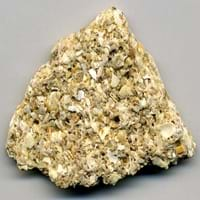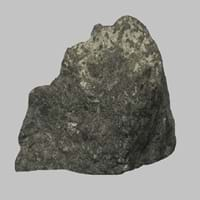Definition
Coquina is a sedimentary rock that is composed either wholly or almost entirely of the transported, abraded, and mechanically-sorted fragments of the shells of molluscs, trilobites, brachiopods, or other invertebrates
Phonolite is an uncommon extrusive igneous rock volcanic rock of intermediate chemical composition between felsic and mafic
Origin
European Foreland Basins
Unknown
Discoverer
Unknown
Unknown
Etymology
From Concha (Latin)+ Coquina(Spanish) +conch(English)= Couquina (mid 19th century)
From the Greek meaning sounding stone because of the metallic sound it produces if an unfractured plate is hit
Class
Sedimentary Rocks
Igneous Rocks
Sub-Class
Durable Rock, Soft Rock
Durable Rock, Medium Hardness Rock
Group
Not Applicable
Not Applicable
Other Categories
Coarse Grained Rock, Opaque Rock
Fine Grained Rock, Opaque Rock
Color
Beige, Buff, Orange
Brown, Buff, Cream, Green, Grey, Pink, White
Durability
Non-Durable
Durable
Appearance
Layered, Banded, Veined and Shiny
Banded and Foilated
Interior Uses
Decorative Aggregates, Homes, Hotels, Interior Decoration
Countertops, Decorative Aggregates, Flooring, Homes
Exterior Uses
Garden Decoration, Office Buildings
As Building Stone, As Facing Stone, Garden Decoration, Office Buildings, Paving Stone
Other Architectural Uses
Curbing
Curbing
Construction Industry
Building houses or walls, Construction Aggregate
As Dimension Stone, Cement Manufacture, Construction Aggregate, for Road Aggregate, Landscaping, Making natural cement, Manufacture of Magnesium and Dolomite Refractories, Production of Glass and Ceramics
Medical Industry
Not Yet Used
Not Yet Used
Antiquity Uses
Artifacts, Monuments, Sculpture, Small Figurines
Artifacts, Monuments, Sculpture
Commercial Uses
Creating Artwork
Cemetery Markers, Creating Artwork
Types
Not Available
Kenyte
Features
Available in Lots of Colors and Patterns, Is one of the oldest rock
Application of acids on the surface causes cloudy frosting, Available in Lots of Colors and Patterns, Dissolves in hydrochloric acid, Is one of the oldest rock
Archaeological Significance
Famous Monuments
Data Not Available
Data Not Available
Famous Sculptures
Data Not Available
Data Not Available
Formation
Coquina is a sedimentary rock which is formed when billions of small clam-like seashell, called Coquina, or cockleshell are die and hence are deposited, buried and turns into a rock when pressure is applied.
Phonolite are formed due to alkaline igneous activities and are generally formed in thick continental crustal areas or in Cordilleran subduction zones.
Mineral Content
Apatite, Augite, Bronzite, Calcite, Chert, Chlorite, Clay Minerals, Epidote, Feldspar, Garnet, Micas, Muscovite or Illite
Albite, Amphibole, Biotite, Cancrinite, Feldspar, Hornblende, Plagioclase, Pyroxene, Sodalite
Compound Content
CaO, Carbon Dioxide, Iron(III) Oxide, MgO
Aluminium Oxide, CaO, Iron(III) Oxide, FeO, Potassium Oxide, MgO, MnO, Sodium Oxide, Phosphorus Pentoxide, Silicon Dioxide, Titanium Dioxide
Types of Metamorphism
Not Applicable
Contact Metamorphism
Types of Weathering
Biological Weathering, Chemical Weathering, Mechanical Weathering
Chemical Weathering, Mechanical Weathering
Types of Erosion
Coastal Erosion, Sea Erosion, Water Erosion, Wind Erosion
Chemical Erosion, Coastal Erosion, Water Erosion, Wind Erosion
Grain Size
Coarse Grained
Fine Grained
Fracture
Irregular
Conchoidal to Uneven
Porosity
Highly Porous
Less Porous
Luster
Dull to Vitreous to Submetallic
Greasy to Dull
Compressive Strength
Not Available
Cleavage
Not Available
Poor
Toughness
Not Available
Not Available
Specific Gravity
1.10-2.24
2.6
Transparency
Opaque
Translucent to Opaque
Density
2.8-2.9 g/cm3
2.6 g/cm3
Resistance
Heat Resistant, Impact Resistant, Pressure Resistant, Wear Resistant
Heat Resistant, Impact Resistant, Wear Resistant
Deposits in Eastern Continents
Asia
Not Yet Found
Indonesia, Iran, Russia, Saudi Arabia, Sri Lanka, Taiwan, Thailand, Turkey, Turkmenistan, Vietnam
Africa
Not Yet Found
Angola, Egypt, Madagascar, Namibia, Nigeria, South Africa
Europe
United Kingdom
Andorra, Finland, France, Germany, Great Britain, Italy, Norway, Portugal, Spain, Sweden
Others
Not Yet Found
Greenland
Deposits in Western Continents
North America
USA
Canada, USA
South America
Not Yet Found
Brazil, Chile, Colombia, Uruguay, Venezuela
Deposits in Oceania Continent
Australia
Not Yet Found
New Zealand, Queensland, South Australia, Tasmania, Western Australia
Coquina vs Phonolite Characteristics
Though some rocks look identical, they have certain characteristics which distinguish them from others. Characteristics of rocks include texture, appearance, color, fracture, streak, hardness etc. Coquina vs Phonolite characteristics assist us to distinguish and recognize rocks. Also you can check about Properties of Coquina and Properties of Phonolite. Learn more about Coquina vs Phonolite in the next section. The interior uses of Coquina include Decorative aggregates, Homes, Hotels and Interior decoration whereas the interior uses of Phonolite include Countertops, Decorative aggregates, Flooring and Homes. Due to some exceptional properties of Coquina and Phonolite, they have various applications in construction industry. The uses of Coquina in construction industry include Building houses or walls, Construction aggregate and that of Phonolite include As dimension stone, Cement manufacture, Construction aggregate, For road aggregate, Landscaping, Making natural cement, Manufacture of magnesium and dolomite refractories, Production of glass and ceramics.
More about Coquina and Phonolite
Here you can know more about Coquina and Phonolite. The life cycle of a rock consists of formation of rock, composition of rock and transformation of rock. The composition of Coquina and Phonolite consists of mineral content and compound content. The mineral content of Coquina includes Apatite, Augite, Bronzite, Calcite, Chert, Chlorite, Clay Minerals, Epidote, Feldspar, Garnet, Micas, Muscovite or Illite and mineral content of Phonolite includes Albite, Amphibole, Biotite, Cancrinite, Feldspar, Hornblende, Plagioclase, Pyroxene, Sodalite. You can also check out the list of all Sedimentary Rocks. When we have to compare Coquina vs Phonolite, the texture, color and appearance plays an important role in determining the type of rock. Coquina is available in beige, buff, orange colors whereas, Phonolite is available in brown, buff, cream, green, grey, pink, white colors. Appearance of Coquina is Layered, Banded, Veined and Shiny and that of Phonolite is Banded and Foilated. Properties of rock is another aspect for Coquina vs Phonolite. The hardness of Coquina is 1-2 and that of Phonolite is 5.5-6. The types of Coquina are Not Available whereas types of Phonolite are Kenyte. Streak of rock is the color of powder produced when it is dragged across an unweathered surface. The streak of Coquina and Phonolite is white. The specific heat capacity of Coquina is Not Available and that of Phonolite is Not Available. Depending on the properties like hardness, toughness, specific heat capacity, porosity etc., rocks are resistant to heat, wear, impact, etc.Coquina is heat resistant, impact resistant, pressure resistant, wear resistant whereas Phonolite is heat resistant, impact resistant, wear resistant.





